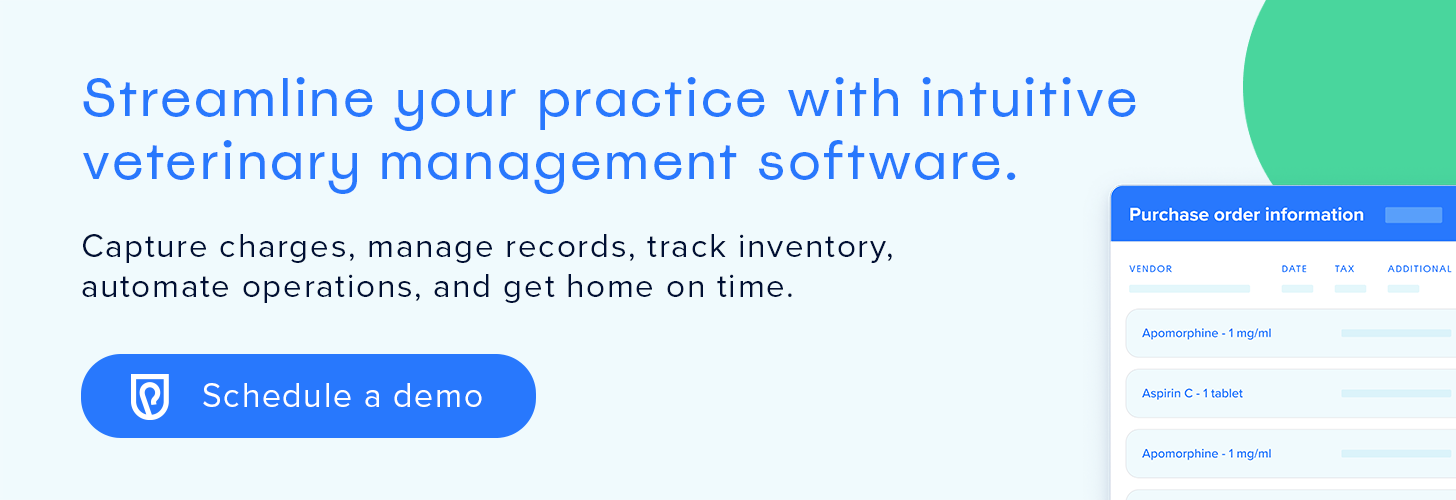Shepherd Veterinary Software & Inventory Ally Integration: Q&A With Nicole Clausen

We recently sat down with Nicole Clausen, founder and president of Inventory Ally, to talk about the recent Inventory Ally integration with Shepherd Veterinary Software. We wanted to give Shepherd users a closer look at how this exciting program can save their practices time and money by automating and optimizing the inventory management process.
Thanks so much for joining us, Nicole. Can you start by explaining Inventory Ally?
Nicole Clausen (NC): Inventory Ally is an all-in-one inventory management program that helps practices by guiding their purchases. We use your purchase history to calculate and determine your minimums and maximums. Basically, you tell Inventory Ally how much you have and it tells you exactly what to order. This is helpful, because a lot of times as an inventory manager, you’re shaking bottles, or you’re like—oh my gosh, I forgot to order this, or somebody forgot to tell me it was low. Now you don’t have to keep that in your brain. Inventory Ally will automate the process and make it easier for you to know exactly what to order and when.
How does Inventory Ally differ from the inventory features included in practice management software?
NC: There are a few really big differences. First, in practice management systems, you typically calculate the order points for items. With Inventory Ally, we work with your practice management software, like Shepherd, and your order history to calculate that for you based on inventory best practices and your unique consumption pattern. These recommendations change according to need. For example, let’s say that all of a sudden you’re dispensing way more gabapentin. As the demand increases, so does your order recommendation. And, vice versa, if you stop selling an item or you’re not selling as much, that recommendation will go down. So, it’s always dynamic, whereas in a practice management system, you have to tell the program what your need is. Using the Shepherd-Inventory Ally integration provides the best of both worlds—an intuitive PIMS, plus an intelligent inventory management platform.
The other benefit of having Inventory Ally is in tracking your white goods and hospital supplies. Because you don’t sell those items, they’re kind of always sitting in your inventory and a lot of manual adjusting is involved. It’ll never flag that you’re running low, like it would if you were selling it. So, it’s really difficult to keep track of those hospital supplies and determine when to order them. Because Inventory Ally uses your practice’s order history to optimize a weekly cycle count schedule, it makes it easy to keep track of all your inventory items and supplies, not only items you sell.
Can you explain a little more about how Inventory Ally determines what and when a practice should order?
NC: When practices first join, they upload their order history into Inventory Ally, and we prioritize every item. We look at the items that you sell or purchase the most versus the least, and we build a cycle count schedule for the practice. There’ll be weekly items, bi-weekly, monthly, and quarterly, because you don’t necessarily need or want to order tongue depressors at the same frequency as popular medications. All the top-selling items will be counted and ordered weekly. At the opposite end of the spectrum, you have items that are counted and ordered quarterly. As the user, you don’t have to set up any of that, because we recommend that frequency cycle for you. You can also change the cycle. Most practices can be up and running and place their first order within 10 to 15 minutes.
Suppose I’m a practice manager sitting down to do my weekly order. What does this look like if I’m using Inventory Ally?
NC: Each week, users get a different subset of their inventory. Based on cycle counts, they’ll have all their weekly items and some of their bi-weekly, monthly, and quarterly items. They tell us how much of those items they have on hand, and when they reach their minimum, we tell them to order up to their max level. That’s what the final result will be—a list of all the items and their recommended order quantity. If they have a Vetcove account, we can push their shopping cart to Vetcove for them. Otherwise, they’ll have a list of items that they can use to guide their ordering.
What benefits can Shepherd users expect from the Inventory Ally integration?
NC: The new integration complements Shepherd’s functionalities by offering additional insights for inventory management optimization. Inventory Ally’s monitoring feature provides real-time updates on stock levels, minimizing the likelihood that practices will run out of stock items and reducing the manual workload associated with physical counts. The integration also benefits the hospital’s financial health by ensuring accurate data and providing additional insights such as product margins, slow-moving inventory, and turnover frequency.
First and foremost, we want to help practices reduce their cost of goods—because that’s the second largest expense in a practice, behind labor. As such, inventory expense is the only lever we can pull to improve practice profitability.
Unfortunately, practices trying to reduce their cost of goods do so by spending less. But, this can create an issue for patient care. If you’re trying to spend less, you can unintentionally create a situation where you’re running out of important products or supplies. Inventory Ally guides supply replenishment so that managers are purchasing appropriate amounts of different items, but also turning over those items, because they’re only ordering what they’re going to use or sell. There’s not a bunch of wasted inventory on the shelf. It’s as if all your little pill vials are stuffed with dollar bills, and if they’re just sitting on the shelf that’s money that could be invested in the practice.
In addition to the financial benefit, we want the veterinary team to be able to spend less time managing their inventory and more time on what matters most—their patients.
Can Inventory Ally help make the manual aspects of inventory, such as counting, more efficient for veterinary teams?
NC: Inventory Ally is mobile-friendly—they just need a web browser—which makes it really easy to delegate counts, because each item is assigned a location in the practice. So, if the inventory manager is on vacation or you want to delegate inventory counting, it’s super easy to do and doesn’t feel so overwhelming. Practices can assign as many or as few locations as they want to an item. When you’re looking at an item you can check the box and see, oh, it lives in the pharmacy and it also lives here or there.
Is there anything else you want readers to know about Inventory Ally?
NC: It’s more than just software. We want to help people address the pain of managing inventory. And while this is a tool that helps them get there, there’s also our customer success team. One of the things I’m proudest of is that everyone on our team is dedicated to making things better and easier for inventory managers and veterinary professionals. That’s really our primary focus.
Where can readers go to learn more about your consulting services or inventory management in general?
NC: They can visit the Inventory Ally site or my website. I also offer training courses and host an inventory podcast. If it’s inventory-related, I’m probably involved somehow. We offer lots of resources that folks can use (e.g., downloadable guides, toolkits), even if they aren’t using Inventory Ally. We have something for everyone.
The Shepherd Veterinary Software team is proud to add Inventory Ally to our library of exciting, industry-leading integrations that help practices experience not only greater efficiency but also greater joy. For more information about activating the Inventory Ally integration, check out our help article or contact our team.
